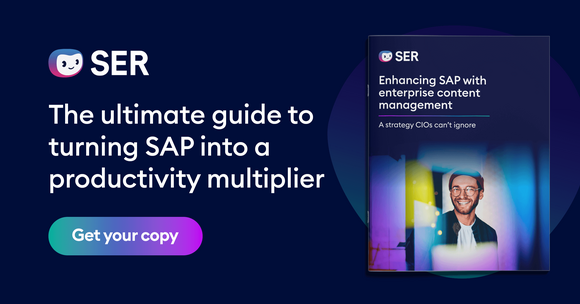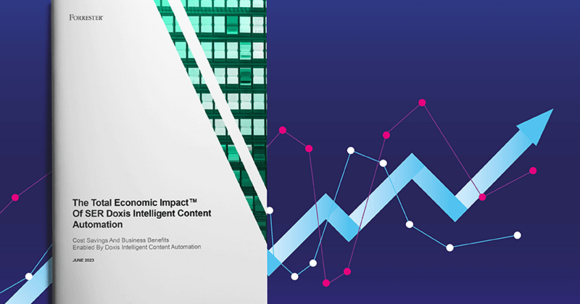SER Blog Innovation & Technology
How IT leaders can prepare for the SAP S/4HANA migration
Gary Crowther
Support for SAP ECC is ending in 2030. As an IT leader, you’re likely considering the migration to SAP S/4HANA, marking a critical update for your systems and a gateway for leveraging new capabilities in data handling and business process management. And while ECC isn’t going to be turned off overnight, it will no longer receive critical updates or maintenance from SAP. So, if you are making the shift, then keep reading to explore how enterprise content management (ECM) can get your data cleaned up and ready during pre-migration while bolstering your organization’s capabilities afterwards. But first, a recap.

Why is SAP discontinuing SAP ECC?
SAP is discontinuing SAP ECC in favor of SAP S/4HANA primarily to keep pace with evolving technology and business demands, marking a fundamental shift in ERP architecture aimed at modernizing processes. ECC, while robust, relies on older database technology, whereas S/4HANA operates on the high-speed, in-memory SAP HANA database. This allows for real-time analytics, faster data processing and seamless integration with emerging technologies such as AI and machine learning.
After 2030, businesses will no longer receive critical updates, including security patches, potentially leaving them exposed to higher operating risks and costly bills from a third-party maintenance provider if they stay the course. By migrating to SAP S/4HANA, organizations gain access to over 600 new functionalities, enhanced analytics and a more agile and scalable system that supports digital transformation initiatives.
The core functionalities of SAP S/4HANA:
- System architecture reengineering
SAP S/4HANA heralds significant changes in system architecture by introducing a simplified data model and a redesigned user interface. This means that the foundational structure of your ERP system will undergo substantial modifications, necessitating a thorough reassessment of your existing customizations and integrations. - Enhanced data processing and throughput
A standout feature of SAP S/4HANA is its in-memory data processing capabilities, which marks a departure from the disk-based processing of its predecessor. This advancement significantly reduces the data footprint and accelerates data processing speeds, facilitating real-time analytics and insights. - Migration path and options
The migration to SAP S/4HANA involves complex decisions, requiring IT leaders to weigh the pros and cons of starting anew (greenfield approach) versus upgrading existing systems (brownfield approach). Each strategy carries distinct implications for data migration, employee training and potential system downtime. - Integration with cloud and hybrid environments
Reflecting the versatility of modern IT environments, SAP S/4HANA offers robust support for various deployment models, including on-premises, cloud and hybrid options. This flexibility allows IT leaders to customize the system deployment to align with the strategic IT roadmaps and cloud policies of their organizations.
Why it’s important to migrate to SAP S/4HANA sooner than later
Migrating to SAP S/4HANA sooner presents an opportunity to optimize your systems on your own terms. Early adoption allows your team to get ahead of potential bottlenecks and complexities while also taking advantage of SAP S/4HANA’s enhanced features in areas like cloud integration and data warehousing. Migrating now gives you more control over timing, resources and adjustments, making it easier to align with broader organizational goals rather than reacting to external pressures later.
Migrating sooner means faster access to some great benefits:
- Improved business agility
Migrating to SAP S/4HANA earlier enables your organization to embrace a more agile operating model. With faster decision-making and streamlined processes, you can respond more effectively to market fluctuations, customer demands and internal business changes. This agility also gives your teams more time to adapt to the system and optimize their workflows, creating a smoother transition in the long term. - Future-proofing your operations
While SAP ECC will continue to receive support until 2030, the technology landscape is evolving at a rapid pace. By migrating now, you’ll be positioning your business to take advantage of new updates, innovations and emerging technologies as they are rolled out, instead of being forced into a rushed transition later on. Proactive migration also reduces the risk of falling behind competitors who may have already made the shift to a more future-proof platform. - Financial considerations
Early migration often comes with cost advantages. As more businesses move to meet the 2030 deadline, resources like consultants, migration specialists and technical support will become more expensive and harder to secure. By moving ahead of the wave, you’re more likely to avoid price hikes, gain access to the best expertise and minimize costly downtime that might occur if you're part of the late surge to migrate. - Operational resilience
Migrating sooner means building operational resilience into your organization’s long-term strategy. SAP S/4HANA’s advanced architecture ensures greater system stability, with less disruption to day-to-day operations. This means fewer issues with system outages or data retrieval delays, giving your business the foundation it needs to maintain resilience and reliability over time.
Prepping for the SAP S/4HANA migration with enterprise content management
Before you gear up for the migration to SAP S/4HANA, we strongly recommend deploying an enterprise content management system (ECM) system. While the end-user benefits of deploying an ECM system to simplify post-migration workflows are well recognized (which we’ll cover a bit further on), its role in safeguarding and facilitating the pre-migration process often goes underappreciated.
However, it’s important to note that ECM is not a migration tool. It does not handle real-time data replication, standardize migration processes and vendors don’t provide services like migration consulting.
An ECM system acts as a stable backbone for data integrity and hygiene before the migration. It ensures that all documents, whether they’re in-flight or at rest, are meticulously cataloged and securely managed. It’s about making sure that no redundant, obsolete or trivial (ROT) data is transferred.

How an ECM system can modernize your document-centric processes
How can an ECM system boost your organization’s efficiency? Which system is right for you? This practical guide helps you to find & implement the right ECM. Incl. checklists, real-life examples, etc.
Get the guideAn ECM system is crucial for pre-migration data hygiene
An ECM system ensures that your data is well-structured and categorized before you even begin your SAP S/4HANA migration. Think of it as an enhancement for SAP: once integrated with SAP ECC, ECM organizes and enriches documents with metadata, storing them in structured files such as customer files and supplier files. This means your data is clean, accessible and optimized—without the need for manual effort.
How ECM supports pre-migration data hygiene
- Organized and structured data:
Documents are systematically categorized, and metadata is extracted, ensuring clarity before migration. - Uninterrupted operations in SAP ECC:
During the configuration period of SAP S/4HANA, employees can continue working in SAP ECC without disruption. - Seamless transition when SAP S/4HANA is ready:
Once your new system is set up, an ECM system can be easily reconnected—like unplugging from ECC and plugging into S/4HANA.
Using ECM pre-migration will also reduce critical risks
Implementing an ECM system before transitioning to SAP S/4 HANA can significantly mitigate several critical risks associated with data management during such a significant system change. Below are the specific risks related to transferring the entire database to SAP S/4 HANA and retaining legacy data on ECC, and how ECM can address these challenges effectively.
Increased system load:
A full database transfer can initially slow down performance due to heavier system load. An ECM system can help by organizing and reducing data volumes before migration, ensuring only essential data is transferred.
Migration complexity and costs:
Complete database migration is inherently complex and costly. By using ECM, businesses can pre-organize and cleanse their data, reducing the data volume and simplifying the migration process.
Inefficiency in data reporting and analytics:
Migrating large volumes of unclassified or redundant data can slow down reporting processes and obscure valuable insights. An ECM system can identify, classify and streamline relevant data, ensuring faster and more accurate analytics in S/4 HANA.
The post-migration benefits of an ECM system
Tons of organizations out there are drowning in information silos and bogged down by mind-numbing manual processes. IT leaders are no longer just the unseen tech gurus tinkering in the background—they’re increasingly seen as the lifeline that can turn these painfully slow workflows into something much smoother.
ECM shines here, stripping away inefficiencies and giving people back hours that were once lost to document hunting or redundant tasks.
Let’s break down exactly how this change impacts the everyday user and the wider organization:
| End User | Organization |
| Simplified document search and retrieval | Centralized control over enterprise documents, reducing silos across departments |
| Automation of routine tasks, freeing up time for higher value activities | Massively increase productivity with faster invoices, quicker deal closures, optimized workloads and just-in-time procurement |
| Enhanced collaboration through seamless document sharing | Faster and significantly more efficient project completion thanks to rapid access to information and streamlined workflows |
| Easy access to documents from anywhere | Compliance with regulatory requirements through secure, organized, and traceable document management |
| Improved productivity by integrating with everyday business applications like ERP and CRM systems | Data-driven insights and reporting, improving decision-making at a strategic level beyond system limits |
Understanding the value of an ECM platform
ECM adopter SEW-EURODRIVE achieved a 336% ROI over a three-year period and a payback in less than six months. Get the full results.
Get the study
Skip the vendor search. Choose the leader in ECM technology
When it comes to selecting the right vendor for your enterprise content management needs, the decision doesn’t have to be complicated. SER’s flagship AI-infused ECM platform, Doxis Intelligent Content Automation, has been recognized as a Leader by analysts and our many customers.
SER’s expertise doesn’t stop at content management. The platform is SAP S/4HANA certified, meaning businesses can seamlessly integrate Doxis with their SAP environments. Whether you’re migrating to SAP S/4HANA or optimizing your operations post-migration, Doxis offers the reliability, security and audit-proof compliance that organizations need to handle their documents efficiently.
Avoid the guesswork and go with the name trusted by global leaders for enterprise content management. Get in touch today.
Gary Crowther
Hello! I’m Gary Crowther, your go-to EN Content Writer and Storyteller at SER, where I transform facts and statistics into narratives that everyone can grasp and act upon. Off the clock, I can be found gaming, hiking, devouring novels and watching films.

The latest digitization trends, laws and guidelines, and helpful tips straight to your inbox: Subscribe to our newsletter.
How can we help you?
+49 (0) 30 498582-0Your message has reached us!
We appreciate your interest and will get back to you shortly.




